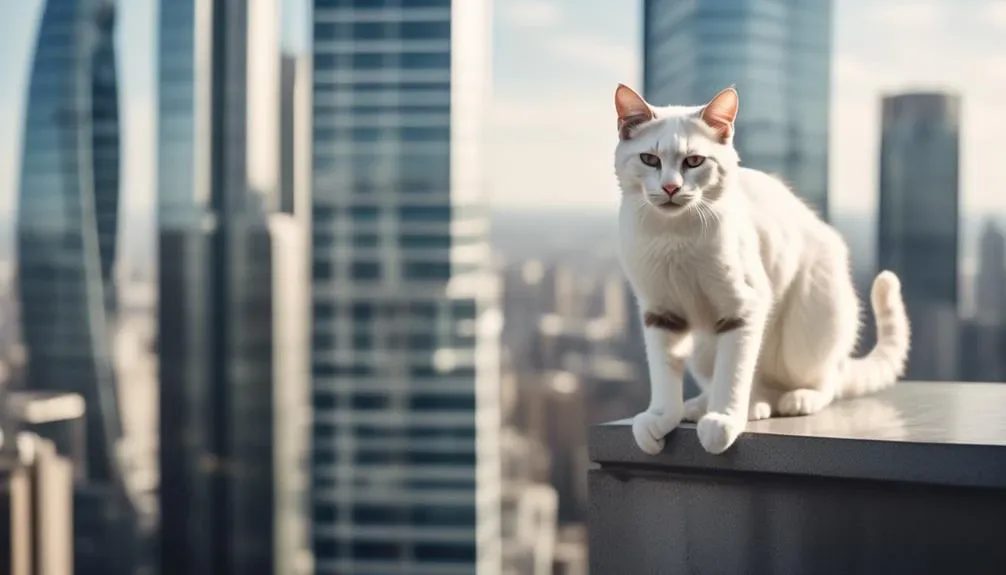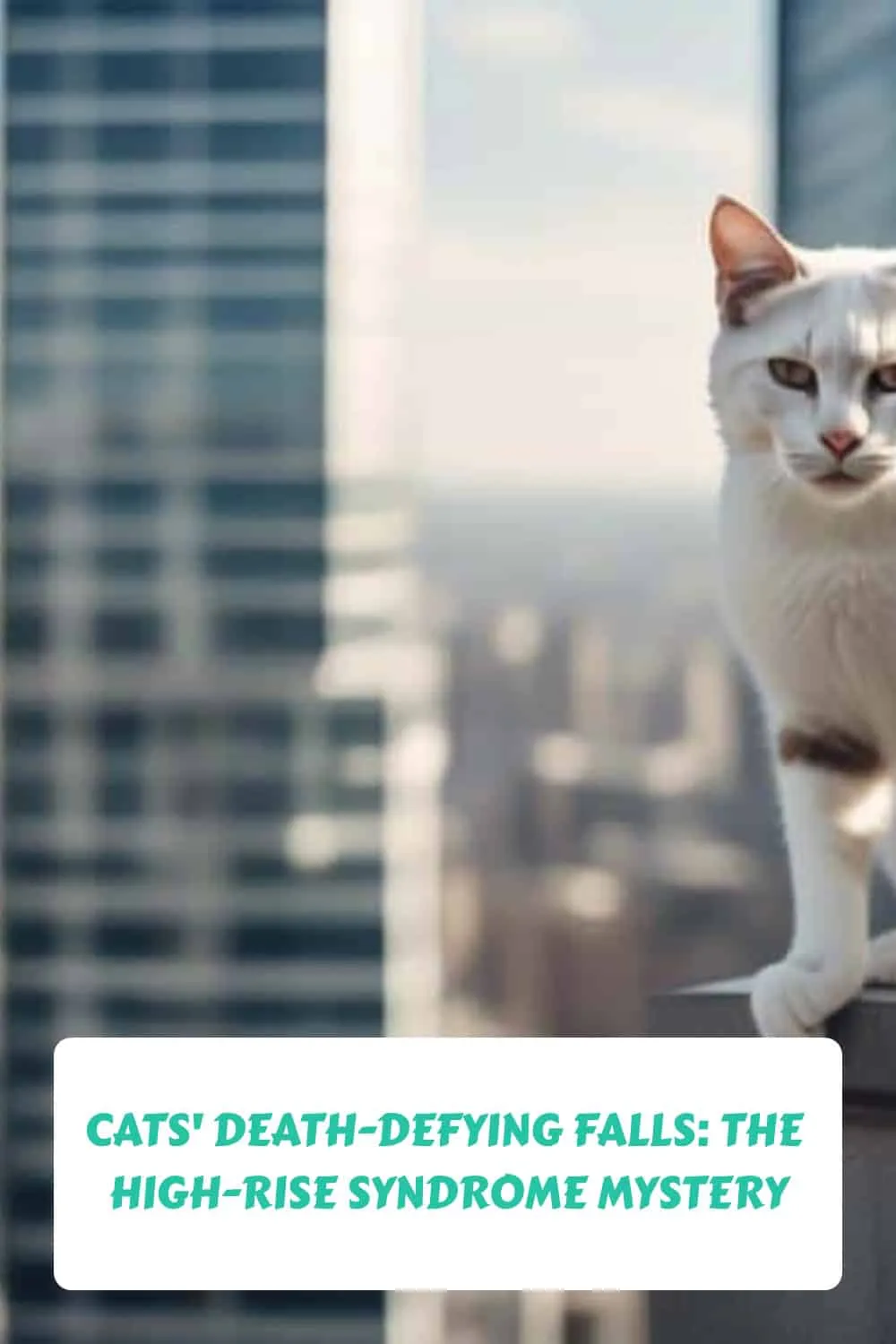The Best Fluffy Pancakes recipe you will fall in love with. Full of tips and tricks to help you make the best pancakes.

The enigmatic phenomenon of cats surviving seemingly impossible falls from high-rise buildings has intrigued and puzzled researchers for decades. High-rise syndrome, as it is known, raises questions about the remarkable abilities of our feline companions and the factors that determine their survival.
From the heights of urban landscapes to the depths of our curiosity, the mystery surrounding these death-defying falls beckons us to explore the intricate web of cat behavior, falling distances, and risk factors that contribute to this perplexing phenomenon.
As we embark on this journey, we will uncover the secrets behind high-rise syndrome and discover practical measures to ensure the safety and well-being of our beloved furry friends.
Key Takeaways
- High-Rise Syndrome is a term coined in NYC during the 1980s to describe the phenomenon of cats falling from tall buildings.
- Cats have a natural righting reflex and flexible skeletal structure that allows them to orient their body for a safe landing.
- Cats can survive falls from various heights, but injuries are more severe for falls under seven stories.
- Preventative measures, such as installing secure screens and keeping cats indoors, can help reduce the risk of high-rise syndrome and protect cats from fall-related injuries and death.
High-Rise Syndrome and Cat Behavior
Cats' natural instincts and behavioral patterns play a significant role in the occurrence of High-Rise Syndrome. The impact of urban environments on cat behavior is a key factor in understanding why cats fall from high-rise buildings.
Cats are naturally curious and agile creatures, which can lead them to explore balconies, open windows, and other elevated areas. Furthermore, the age and physical condition of cats contribute to the incidents of high-rise syndrome.
Kittens may not have fully developed their righting reflex, making them more vulnerable to falls. On the other hand, senior cats may experience weakened bones and decreased agility, increasing their risk of falling.
Understanding these behavioral and physiological factors can help cat owners take appropriate measures to prevent high-rise syndrome incidents.
Understanding Falling Distance for Cats
The distance from which cats can fall without sustaining injury is influenced by various factors and has been the subject of scientific study. Understanding the falling distance for cats requires an examination of feline anatomy and survival instincts.
Factors Affecting Falling Distance:
- Feline Anatomy
- Unique skeletal structure contributes to agility
- Lack of collarbone and flexible spine enhance flexibility
- Survival Instincts
- Cats possess a righting reflex that corrects body orientation for a safe landing
- Reflex observed in kittens as young as 3 weeks old
Scientific studies have shown that there is no exact distance from which cats can fall without injury, as it depends on multiple variables. However, a study conducted in 1987 found that cats fell an average of 5.5 stories before requiring emergency care. Falls under seven stories resulted in more severe injuries. While rare, cats have been known to survive falls from over 30 stories.
It is important to consider these factors when assessing the potential risks and implementing measures to keep cats safe from high-rise syndrome.
Identifying Potential Risk Factors
Understanding the factors that contribute to high-rise syndrome in cats involves identifying potential risk factors that can increase the likelihood of falls and injuries.
Age and reflex development play a significant role in a cat's ability to land safely after a fall. Kittens, for example, may not have fully developed their righting reflex, making them more susceptible to injuries. Additionally, senior cats may have weaker bones and reduced agility, further increasing their risk.
Another important risk factor to consider is the impact of weight on falls. Cats with excessive weight may have limited flexibility and increased impact upon landing, making them more prone to serious injuries.
Tips for Keeping Your Cat Safe
Implementing preventive measures is crucial for ensuring the safety of your cat and minimizing the risk of high-rise syndrome. To keep your cat safe, it is important to take balcony safety precautions and prioritize the importance of secure window screens.
Here are some tips to consider:
- Balcony safety precautions:
- Supervise your cat when on a balcony or terrace to prevent unsupervised access.
- Consider using deck netting or mesh to prevent falls through larger gaps in balcony or terrace borders.
- Keep patio furniture away from balcony or terrace railings to prevent climbing and falling hazards.
- Importance of secure window screens:
- Install secure window or door screens to prevent accidental falls.
- Check screens frequently for stability and holes.
- Avoid opening windows without screens and keep all doors and windows securely closed.
Importance of Indoor Living for Cats
Indoor living for cats is essential for ensuring their safety and well-being. The consequences of high-rise syndrome, which can result in serious injury or death for cats, highlight the importance of keeping them indoors.
While outdoor living may offer certain advantages, such as exposure to fresh air and natural stimuli, the risks associated with falls from heights outweigh these benefits. Cats possess natural righting reflexes and flexibility, but even falls from shorter distances can lead to significant injuries. The lack of collarbone and flexible spine contribute to their agility, but these factors also make them vulnerable to high-rise syndrome.
Additional Information and Prevention Measures
To mitigate the risks of high-rise syndrome and prevent fall-related injuries in cats, it is crucial for owners to implement effective prevention measures. These prevention methods can significantly reduce the incidence of common injuries associated with falls from high-rise buildings. Here are some key prevention measures to consider:
- Install secure window or door screens:
- Regularly check screens for stability and holes.
- Avoid opening windows without screens.
- Keep all doors and windows securely closed.
- Supervise your cat on balconies or terraces:
- Prevent unsupervised access to heights.
- Consider using deck netting or mesh to prevent falls through larger gaps.
- Keep patio furniture away from railings to prevent climbing hazards.
Conclusion
In conclusion, high-rise syndrome poses a significant risk to cats in urban environments. While cats have a remarkable ability to land on their feet, the severity of their injuries remains uncertain due to various factors.
Preventive measures such as keeping cats indoors and implementing secure window screens and closed doors are crucial in safeguarding them from fall-related injuries. By understanding the risks and taking appropriate precautions, cat owners can protect their feline companions and prevent the tragedy of death-defying falls.
As the saying goes, 'An ounce of prevention is worth a pound of cure.'










